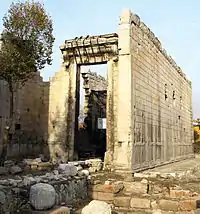Res Gestae Divi Augusti
Res Gestae Divi Augusti (Eng. The Deeds of the Divine Augustus) is a monumental inscription composed by the first Roman emperor, Augustus, giving a first-person record of his life and accomplishments.[1] The Res Gestae is especially significant because it gives an insight into the image Augustus offered to the Roman people. Various portions of the Res Gestae have been found in modern Turkey. The inscription itself is a monument to the establishment of the Julio-Claudian dynasty that was to follow Augustus.[2]
Structure
The text consists of a short introduction, 35 body paragraphs and a posthumous addendum. The paragraphs are conventionally grouped in four sections,[3] political career, public benefactions, military accomplishments and a political statement.
The first section (paragraphs 2–14) is concerned with Augustus' political career; it records the offices and political honours that he held. Augustus also lists numerous offices he refused to take and privileges he refused to be awarded. The second section (paragraphs 15–24) lists Augustus' donations of money, land and grain to the citizens of Italy and his soldiers, as well as the public works and gladiatorial spectacles that he commissioned. The text is careful to point out that all this was paid for out of Augustus' own funds. The third section (paragraphs 25–33) describes his military deeds and how he established alliances with other nations during his reign. Finally the fourth section (paragraphs 34–35) consists of a statement of the Romans' approval for the reign and deeds of Augustus. The appendix is written in the third person and likely not by Augustus himself. It summarizes the entire text, lists various buildings that he renovated or constructed and states that Augustus spent 600 million silver denarii (600,000 gold denarii) from his own funds during his reign on public projects. Ancient currencies cannot be reliably converted into modern equivalents, but it is clearly more than anyone else in the empire could afford. Augustus consolidated his hold on power by reversing the prior tax policy beginning with funding the aerarium militare with 170 million sesterces of his own money.[4][5]
History

According to the text it was written just before Augustus' death in AD 14, but it was probably written years earlier and likely went through many revisions.[6] Augustus left the text with his will, which instructed the Senate to set up the inscriptions. The original, which has not survived, was engraved upon a pair of bronze pillars and placed in front of Augustus' mausoleum. Many copies of the text were made and carved in stone on monuments or temples throughout the Roman Empire, some of which have survived; most notably, almost a full copy, written in the original Latin and a Greek translation was preserved on a temple to Augustus in Ancyra (the Monumentum Ancyranum of Ankara, Turkey); others have been found at Apollonia and Antioch, both in Pisidia.
Content
The text is not a full account of the years between 44 BC, the assassination of Augustus' adoptive father Julius Caesar, and AD 14, the year in which he died. Instead, it is a personal account of the first Emperor's life and those achievements that he decided to be worth remembering by the Roman people.[7] It is an independent self-depiction that is written in a literary form which is unique to the ancient world, and it must be read as such.[8] This period of history is seen from Augustus' perspective and the author presents facts that relate only to himself. Augustus' enemies are never mentioned by name.[9] Caesar's murderers Brutus and Cassius are called simply "those who killed my father". Mark Antony and Sextus Pompey, Augustus' opponents in the East, remain equally anonymous; the former is "he with whom I fought the war," while the latter is merely a "pirate." While certainly one-sided, it cannot be stated that Augustus made any false statements.[10] Any comprehensive understanding of this period of Roman history should be supplemented by statements from other ancient sources, archaeology, and inscriptions.
See also
- Lucius Cornelius Scipio Barbatus, whose sarcophagus carries a short inscription in Saturnian metre commemorating his deeds
- Behistun Inscription, commissioned by Darius I of Persia
- Res Gestae (disambiguation)
References
- Augustus (14 May 2009). Res Gestae Divi Augusti. Cambridge University Press. ISBN 978-0-521-84152-8.
- Understanding Roman Inscriptions by Lawrence Keppie. ISBN 0415151430. 1991. pp. 132–133
- However, there are other possible groupings; see discussion in Scheid, "Introduction", XXXVI–XLIII.
- Aug. RG 17.2
- The Class Struggle in the Ancient Greek World. G.E.M. de Ste. Croix p362 Cornell University Press 1981 ISBN 0-8014-9597-0
- Eck, W. (2007) The age of Augustus. 2nd edn. Oxford: Blackwell, p. 169. ISBN 978-1-4051-5149-8
- Eck, 2006 131
- Eck, 2006 133
- Eck, p. 171.
- Eck, 2006 133
Sources
- Barini, Concetta (1937), (in Ancient Greek and Latin) Res Gestae Divi Augusti ex Monumentis Ancyrano, Antiocheno, Apolloniensi, Rome.
- Cooley, Alison (2009), (in English) Res Gestae divi Augusti: Text, Translation and Commentary, Cambridge: Cambridge University Press, 2009. ISBN 978-0-521-84152-8
- Eck, Werner (2006), The Age of Augustus, London: Blackwell.
- Gagé, Jean (1935), Res gestae divi Augusti ex monumentis Ancyrano et Antiocheno latinis, Paris.
- Mommsen, Theodor (1865). Res gestae Divi Augusti ex monumentis Ancyrano et Apolloniensi. Berolini: Weidmannos, 1865.
- Scheid. John (2007). (in French) Res Gestae Divi Augusti: hauts faits du divin Auguste. Paris: Belles Lettres, 2007. ISBN 978-2-251-01446-3
- Volkmann, Hans (1942), Res gestae Divi Augusti Das Monumentum Ancyranum, Leipzig.
External links
| Wikimedia Commons has media related to Res gestae Divi Augusti. |
| Wikisource has original text related to this article: |